Glass Kitchen Doors: Styles & Options Buyer’s Guide
Table of Contents
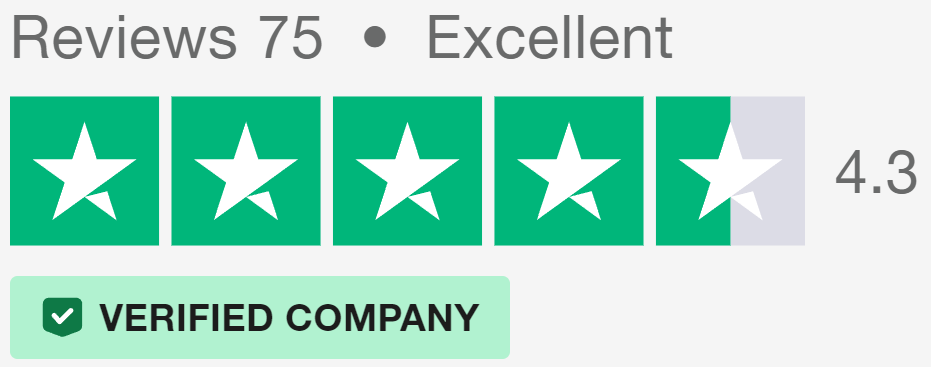
Types of Glass Kitchen Doors for Different Spaces
Glass kitchen doors bring natural light and garden views into cooking spaces of all shapes and sizes. Modern designs range from simple sliding panels to intricate folding systems, each suited to particular layouts and needs.
Sliding Glass Doors in Long, Narrow Kitchens
Narrow galley kitchens often struggle with darkness, particularly in older terraced houses. Sliding kitchen doors shine in these spaces, running parallel to the work surfaces without swinging into valuable floor space. Wide glass panels glide smoothly along high-quality tracks, drawing daylight deep into the room while maintaining a practical workflow.
Running the full height from floor to ceiling, large-format sliding doors can make even the most compact galley feel open and bright. Track systems mounted at the top of the frame eliminate trip hazards, while bottom guides ensure stable operation without intruding into the kitchen space.
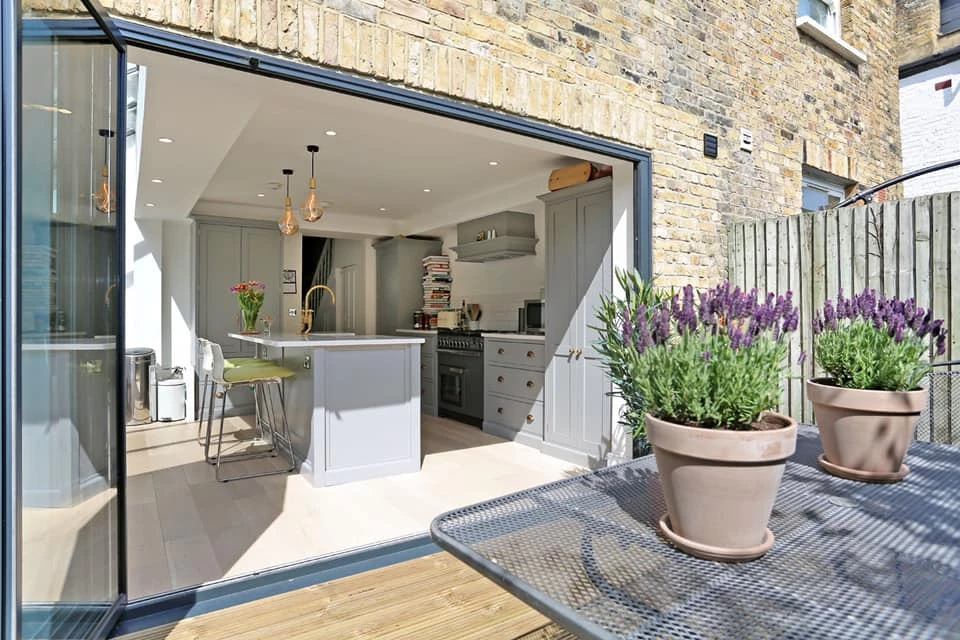
Bifold Doors in Open-Plan Kitchens
Kitchen extension bifold doors work brilliantly in wider openings, folding away completely to merge indoor and outdoor spaces. Unlike sliding systems, bifolds can span broader apertures while still tucking neatly to one side when open. The accordion-style operation suits social kitchen-diners where you’ll frequently move between cooking and outdoor dining areas.
Multi-panel configurations allow you to partially open sections for ventilation while keeping other panels closed. This flexibility proves particularly useful in British weather, letting you adjust the opening to suit changing conditions throughout the day.
When to Choose Slide and Turn Doors
Slide and turn doors offer a smart middle ground between bifolds and sliders. Individual panels glide along the track before pivoting independently, ideal for kitchens with unusual angles or limited space for door stacking. The panels can be positioned anywhere along the track, giving you precise control over the size of the opening.
Frameless Glass Door Options
Minimal Frame Designs
Glass doors for kitchens now come in ultra-minimal designs with frames barely visible to the eye. These sophisticated systems use specially toughened glass panels that require minimal vertical supports, creating an almost invisible barrier between inside and out. The clean lines complement different kitchen styles from traditional to contemporary, while still providing the security and weather protection needed for daily use.
The slim frames disappear into the ceiling void and floor channel, leaving pure sheets of glass that showcase garden views. Advanced roller mechanisms ensure smooth operation despite the substantial weight of the panels, while multiple locking points maintain security without bulky visible hardware.
Glass Kitchen Door Styles and Kitchen Design
Modern glass kitchen doors come in a striking range of designs that can define your kitchen’s character. The right style choices create visual harmony between your door frames, kitchen units, and overall room design.
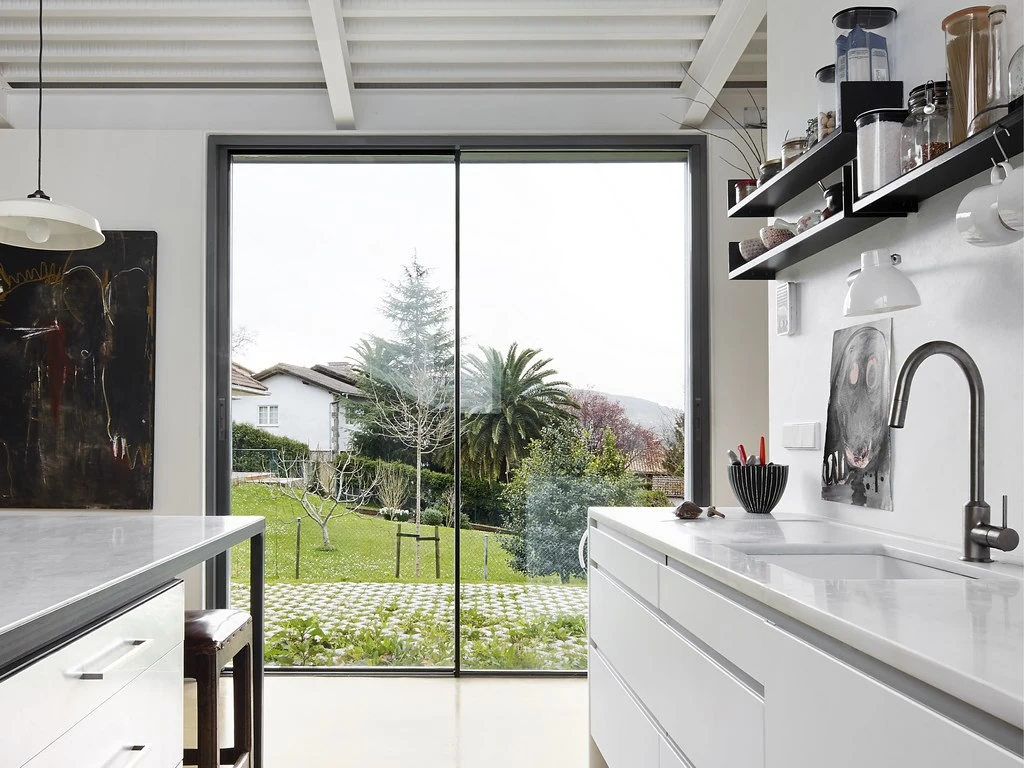
Matching Door Frames to Kitchen Units
Kitchen cabinets set the tone for the entire space, making frame colour selection particularly important. Powder-coated aluminium framed sliding doors offer a spectrum of finishes, from matt charcoal that pairs beautifully with dark wood units to metallic bronze that adds warmth alongside cream shaker-style cabinets. The frame thickness matters too – chunkier frames echo traditional cabinet styling, while minimal frames suit sleek, contemporary units.
Painted timber frames give glass kitchen doors a softer, more traditional feel that works well with hand-painted kitchen designs. These frames can be repainted to match new kitchen colour schemes, letting you refresh the whole look without replacing the doors. When choosing hardware, opt for handles and locks in finishes that match your cabinet hardware for a coordinated appearance.
Glass Types and Kitchen Light
Clear vs Textured Glass
The glass you choose for your kitchen doors shapes how light moves through your space. Clear glass kitchen doors flood rooms with unfiltered sunlight, while reeded or fluted panels diffuse harsh rays and add visual interest. Sandblasted sections at eye level maintain privacy without blocking light, particularly useful for ground-floor kitchens overlooking neighbouring gardens.
Low-iron glass removes the slight green tint found in standard glass, showing true colours more accurately – especially important if you’re coordinating with specific paint shades or materials in your kitchen. Slim frame patio doors often use this premium glass type to improve clarity and light transmission.
Bold vs Subtle Door Designs
Large-format glass kitchen doors become striking architectural features in their own right. Black powder-coated frames create bold geometric patterns that contrast with light walls and units. This high-contrast approach suits industrial-style kitchens with exposed brick or concrete elements.
For quieter impact, slim frames in neutral tones let the glass kitchen doors themselves become the focus. These understated designs put emphasis on the views beyond while still providing the practical benefits of glass doors for kitchens. The minimal aesthetic pairs particularly well with handle-free kitchen designs where clean lines dominate.
Coordinating Materials and Finishes
Matching materials across your kitchen creates visual flow. If you’ve chosen stainless steel appliances, metallic door frames in similar tones maintain consistency. Stone flooring that continues through glass doors to outdoor terraces connects inside and outside spaces visually, while coordinated wall colours either side of the doors prevent jarring transitions.
Steel-look frames complement industrial-style pendant lights and metalwork details, creating a cohesive design scheme. When working with period properties, selecting frame profiles that echo existing architectural features helps glass doors sit naturally within the space. Victorian-era homes often benefit from slimmer frames with decorative glazing bars that reference traditional window patterns.
Frame Finish Selection
Frame finishes need careful thought beyond pure aesthetics. Matt finishes hide fingerprints better than gloss, making them practical choices for family kitchens. Textured powder coatings provide extra durability against scuffs and scratches in high-traffic areas. Anodised aluminium offers excellent longevity while providing subtle metallic sheens that catch light beautifully.
Planning Your Glass Kitchen Doors Layout
Glass kitchen doors need thoughtful placement to work with your room’s shape, size, and intended use. Smart positioning improves how you move through the space while bringing in plenty of natural light.
L-Shaped Kitchen Door Placement
L-shaped kitchens offer multiple possibilities for door positioning, each with distinct advantages. Placing glass kitchen doors in the shorter leg of the L creates an impressive view from the main cooking area, while installation along the longer run opens up more of the garden. The corner itself often houses tall units or appliances, so door placement needs to avoid blocking access to these essential features.
Sliding doors for open plan kitchens fit particularly well in L-configurations, as they don’t swing into either leg of the L when opening. This preserves valuable corner space that might otherwise be lost to door clearance. Wide sliding panels also let you position the opening exactly where you need it, rather than being limited by hinge positions.
Corner posts can be eliminated in some modern glass door systems, creating completely open corners when the doors are pulled back. This arrangement works brilliantly in L-shaped kitchens that wrap around a patio or deck, removing visual barriers between different outdoor zones.
Garden-Facing Door Positions
The orientation of glass doors for kitchens strongly influences natural light levels throughout the day. South-facing doors capture maximum sunlight but might need extra shading during summer months. East-facing positions bring morning light ideal for breakfast areas, while west-facing glass kitchen doors create beautiful evening atmosphere for dining spaces.
Garden views through glass kitchen doors become focal points, so think about what you’ll see from key working positions. Placing doors where they frame attractive garden features adds visual interest, while thoughtful positioning can screen less appealing elements like bins or storage areas. Distance from neighbours’ windows also needs careful planning to maintain privacy on sides.
When replacing existing windows or doors with larger glass kitchen doors, structural factors come into play. Load-bearing walls require proper support above new openings, while bespoke sizes let you make full use of available space without compromising on stability.
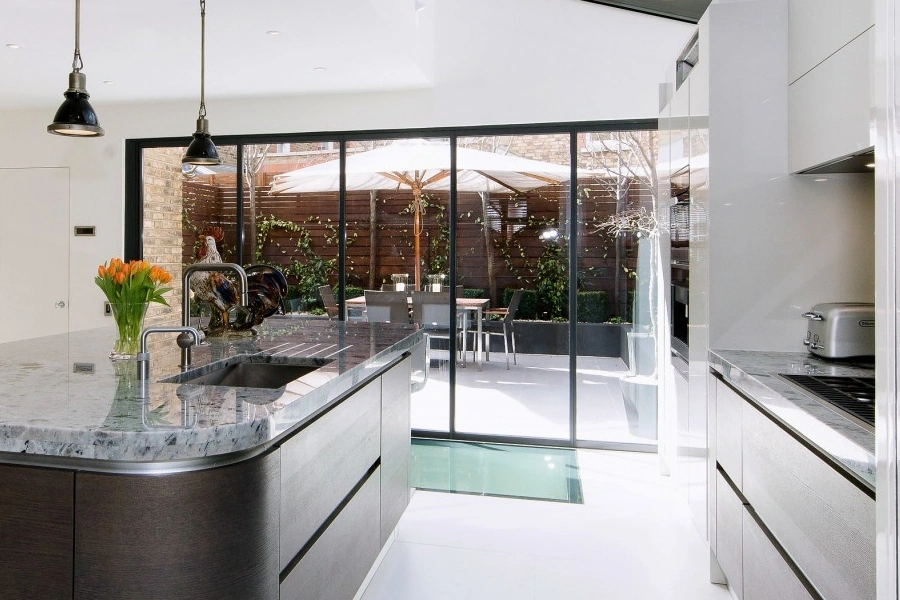
Working Around Kitchen Units
Traffic Flow Planning
The route between your main work zones needs to stay clear and practical. Drawers and cupboards should open fully without clashing with door frames, while appliance doors – especially full-height fridge freezers – need proper clearance. The kitchen triangle between sink, hob, and fridge shouldn’t be interrupted by door placement or operation.
Preparation areas work well when positioned near to glass kitchen doors, allowing easy transfer of food to outdoor dining spaces. However, avoid placing hobs directly next to doors where drafts might blow out gas flames or carry cooking odours outside.
The sink position relative to doors also needs thought – you might want to gaze out while washing up, but splashes can mark glass panels over time.
Bar or breakfast counters can be integrated alongside glass door installations, creating sociable spaces that benefit from natural light. These casual dining spots bridge indoor and outdoor areas effectively, especially when the counter material continues through to exterior surfaces.
Walking routes through the kitchen should flow naturally towards door openings without creating bottlenecks. This becomes particularly important in busy family kitchens where multiple people move between spaces at once. Door thresholds need to sit flush with floor levels on each side, preventing trip hazards while allowing smooth movement of serving trolleys or kitchen equipment between inside and out.
Glass Kitchen Doors and Privacy
Privacy needs vary throughout the day in kitchens with large glass expanses. Smart design choices help balance openness with seclusion exactly when you need it.
Privacy Glass Options
Modern glass kitchen doors offer sophisticated privacy features without sacrificing natural light. Switchable glass panels change from clear to opaque at the touch of a button, giving instant privacy when needed. This technology suits urban kitchens particularly well, letting you adjust visibility as neighbours come and go.
Traditional obscured glass patterns now come in contemporary designs that add visual interest while maintaining privacy. Fluted or reeded glass creates subtle distortion that increases with viewing angle – people walking directly past see only vague shapes, while you still enjoy clear garden views when seated at your kitchen table.
Kitchen extension sliding doors often incorporate zoned privacy glass, with clear panels at eye level for views and obscured sections below. This layered approach maintains privacy from passing pedestrians while keeping the connection to outdoor spaces. Partial sandblasting or gradient patterns can also hide specific areas like under-counter storage without blocking all visibility.
Balancing Light and Privacy
Glass kitchen doors flood spaces with natural light, but this can sometimes work against privacy needs. Reflective glass treatments reduce glare while limiting visibility from outside, especially effective during daylight hours. At night, the effect reverses – interior lighting makes kitchens more visible from outside, requiring additional privacy measures.
Adjustable shading systems work neatly with many glass kitchen door designs. Blinds tucked into door frames disappear when not needed, while external awnings or louvres control light levels and visibility. Some systems can be automated to respond to sunlight levels or time of day, maintaining privacy without constant adjustment.
Strategic Lighting
Well-planned kitchen lighting helps control privacy levels after dark. Under-cabinet lights and pendant fittings focused on work surfaces provide task lighting without creating a fishbowl effect. Dimmer switches let you adjust overall light levels to suit different activities and times of day.
External lighting plays an important role too. Carefully positioned garden lights draw the eye outward through glass panels rather than inward, while subtle uplighting of trees or features creates attractive views that work year-round. Motion-activated security lights can be positioned to avoid glare through kitchen glass doors while still providing safety benefits.
Adapting Privacy Measures
City kitchens with overlooking neighbours might need permanent privacy solutions, while rural settings allow more flexibility. Retractable screens offer on-demand privacy without permanent barriers, particularly useful for kitchen-diners that serve different purposes throughout the day. These systems can be motorised for easy operation, even across large glass expanses.
The angle and position of glass kitchen doors relative to neighbouring properties shapes privacy requirements. Doors facing side boundaries often need more screening than those opening onto rear gardens, while upper floor kitchen extensions require careful privacy planning to avoid overlooking issues.
Making the Most of Glass Kitchen Doors
Large glass kitchen doors completely change how you use and move through your kitchen space. From morning coffee to evening dinner parties, they shape daily routines and social gatherings all year round.
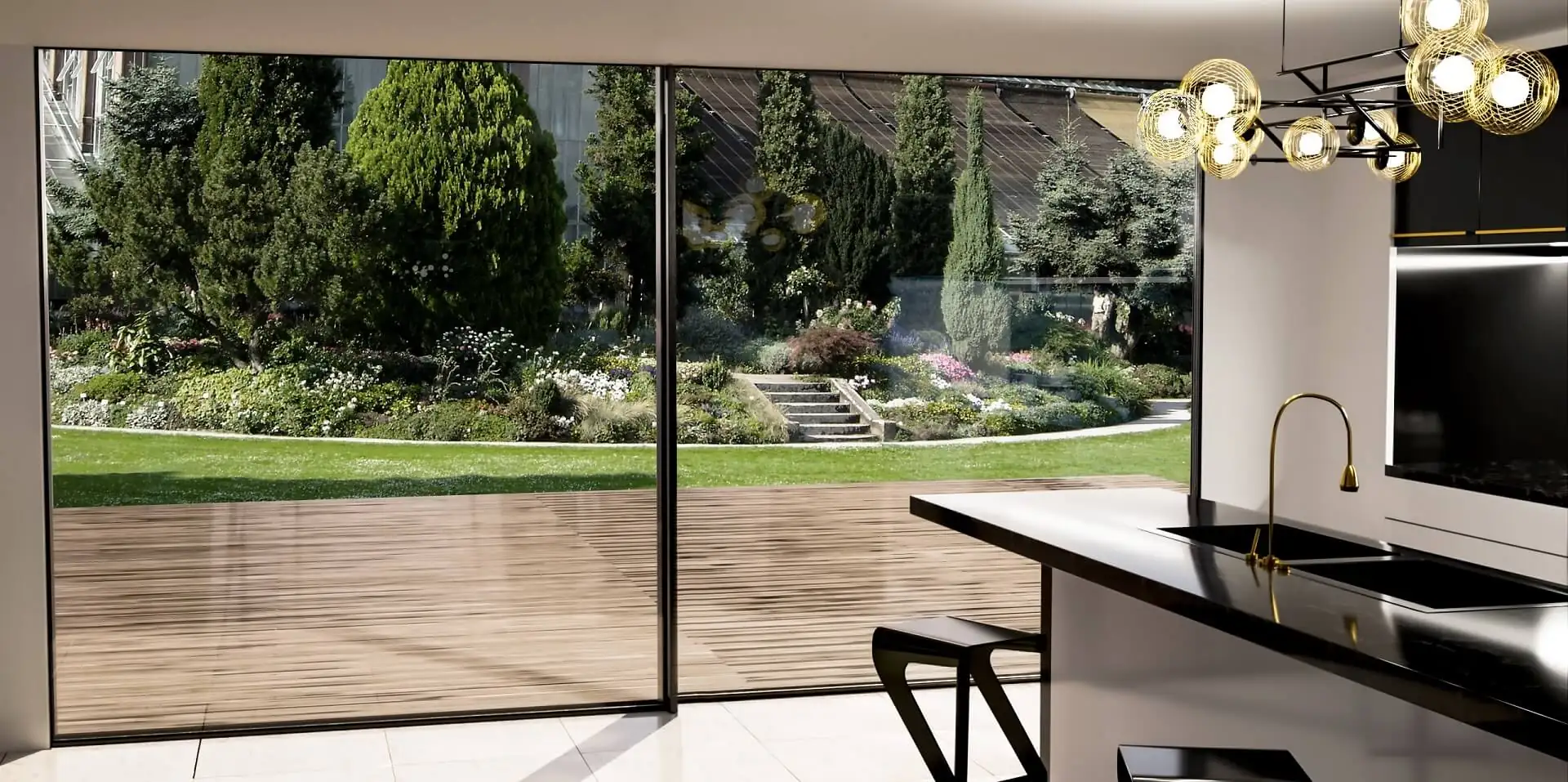
Kitchen-Garden Flow
Glass doors for kitchens create natural gathering spots where people instinctively pause and congregate. Placing casual seating near these openings draws family and guests toward garden views, while keeping them close enough to chat with those preparing food.
A well-positioned kitchen island or breakfast bar near glass kitchen doors lets you serve drinks or snacks directly to outdoor spaces.
Gardens become true extensions of the kitchen when the boundaries between spaces disappear.
Matching floor levels inside and out prevents awkward steps, while coordinated paving or decking creates visual continuity. Herb planters and kitchen gardens positioned near glass kitchen doors bring greenery closer, making harvesting fresh ingredients part of the cooking experience.
Light Control Methods
Morning sun streaming through east-facing glass kitchen doors creates beautiful natural illumination for breakfast time. However, strong sunlight can cause glare on worktops and make temperature control challenging. Remote-controlled blinds fitted within door frames provide quick adjustments without spoiling clean lines, while external awnings add character while blocking harsh rays.
Seasonal Adaptations
The British weather demands flexibility in how we use our kitchens throughout the year. Partial opening configurations let you ventilate cooking spaces without creating drafts, while good seals prevent heat loss when doors are closed. Underfloor heating near glass panels eliminates cold spots in winter, making the whole space comfortable year-round.
Zoning with Glass Doors
Modern kitchens often serve multiple purposes simultaneously – cooking, dining, working, and socialising. Glass door placement helps define these different zones naturally. A homework space tucked to one side of a glass opening benefits from natural light while staying separate from main cooking areas, and utility spaces behind closed sections maintain their practicality without spoiling views.
Activity Zones
Food preparation areas work well when positioned to take advantage of natural light from glass panels. Locating main worktops where they receive good daylight reduces reliance on artificial lighting, while placing sinks near glass doors creates pleasant views during cleanup tasks. The cooking zone itself needs careful positioning – not too close to opening sections where drafts might cause problems, but close enough to vent cooking odours easily when needed.
Different door configurations suit different activities. Wide openings work brilliantly for summer parties, letting guests move freely between kitchen and garden. Smaller opening sections provide quick access for checking on children playing outside or grabbing herbs from garden planters. The key lies in choosing opening styles that match your typical daily patterns.
Sound Management
Open plan layouts with large glass doors can create acoustic challenges. Hard surfaces reflect sound, potentially making spaces feel noisy when doors are closed. Soft furnishings, textured wall treatments, and carefully chosen flooring materials help absorb sound without compromising the clean lines of contemporary glass installations. Acoustic glass options provide extra sound insulation where needed, particularly useful in urban settings or near busy gardens.
Party walls shared with neighbours need special attention when installing glass kitchen doors. Sound transmission through the structure can increase when removing solid walls, so additional acoustic measures might be needed. Professional advice ensures compliance with building regulations while maintaining good neighbour relations.
We’d Love to Help You
Vision Glass Doors is a designer, manufacturer, and installer of premium door systems. We are a family run business with over 20 years’ experience and 5,000 installations across the UK.
Our leading range of door systems include Ultra Slim – Slide and Turn Doors, Slimline Sliding Patio Doors and Frameless Glass Doors. Suitable for various internal and external applications, they are applicable to residential and commercial projects.
Click Quick Quote Online for a free quotation within 24 hours. Alternatively, call or email us on 01582 492730 or at info@visionglassdoors.co.uk.

